
What’s wrong with my lemon tree?” and “Why isn’t my new citrus tree growing yet?” are two of the most common questions I get asked. So to try and help you all get the best out of your citrus trees, I’ve put together this comprehensive guide to growing citrus in Melbourne. It’s so big that I’ve split it into five parts:
Citrus Growing Guide Part 2: Where and How to Plant Your Citrus Tree
Citrus Growing Guide Part 3: Ongoing Care and Management of Citrus Trees
Citrus Growing Guide Part 4: Pruning and Shaping of Citrus Trees
Citrus Growing Guide Part 5: Citrus Pests, Diseases and Problems in Melbourne
Growing Citrus in Melbourne
Of all the fruit trees, Citrus are the most popular backyard trees in Melbourne. Citrus trees are attractive evergreens and fit well into the garden landscape with their glossy green foliage, beautiful white scented blossoms and colourful fruit. I think that citrus make an attractive substitute for camellias, with the added bonus of producing fruit. All varieties of citrus ripen slowly and can be left on the tree to be harvested at leisure.
The wild ancestors of most citrus fruit are native to Asia, ranging from North East India, across to China and south to Australia. The Chinese were cultivating citrus well before 2000BC. Australia has eight native citrus species.
In Australia, oranges, lemons and limes were introduced in 1788, by the First Fleet settlers. Since then, many new cultivars and rootstocks have been introduced. As a result we now have an enormous range of citrus to choose from.
Each species of citrus varies in its ability to withstand frost and also varies in the amount of heat required to ripen. Unfortunately these two factors are not usually related. For example the lemon, which ripens very well in Melbourne’s cooler climate, is also a little prone to frost and can look quite sickly in winter. On the other hand the orange is extremely frost tolerant, yet can produce fruit that remain small and a little sour in cooler climates. Therefore, it is important to select the right varieties for growing in Melbourne and plant them in the most suitable locations in your home garden.
Note: There are many varieties available to commercial growers, that are covered by plant variety rights, and are not readily available to home gardeners. I have not included these here. I have also excluded those varieties not normally grown successfully in Melbourne climates.
Citrus Varieties Available to the Home Grower
Sweet Orange (Citrus sinensis)
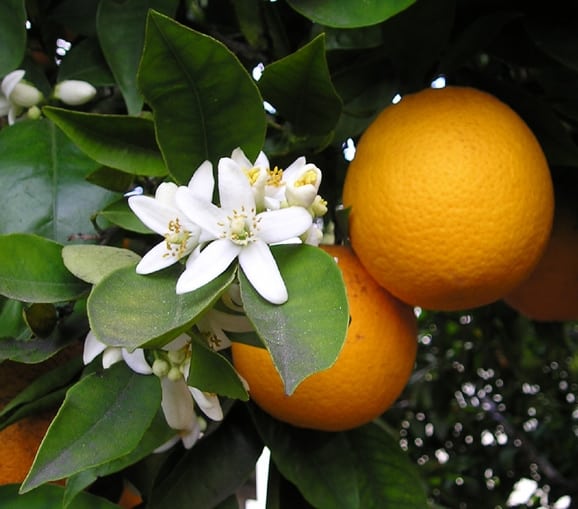
Orange trees are usually frost hardy but fruit is often sour in cooler climates. There are two main groups of sweet oranges navels (seedless) and common oranges (seedy)
‘Washington’ Navel
Is the most popular and best known eating orange. A medium sized tree that performs well in mild coastal climates.The juice may become bitter if stored for more than a day or two. The Washington navel needs less heat than any other Navel.
‘Leng’ Navel
The fruit is juicy and ripens earlier than ‘Washington’ navel. Splitting and premature dropping of fruit can be a problem in some seasons.
‘Lane Late’ Navel
Similar to ‘Washington’ Navel, this variety matures later and remains on the tree in good condition until Christmas.
TOC Summer Navel
Fruit is large and very juicy with an excellent flavour. TOC Summer navel is a late holding navel and crops well into summer.
Navelina
Suits cold climates. Fruit ripens end of April into May, making it a fantastic early season navel orange, which is sweet, seedless and juicy. Fruit can be slightly oblong in shape and has a dark orange skin. The tree is compact and bushy.
Fukomoto
Suits cold climates and is an early maturing navel. Trees tend to be slow growing with moderate yields. Fruit is round in shape and rapidly loses flavour due to low acidity
Valencia
Mature by September, ‘Valencia’ reaches peak sweetness and juiciness through November and December. ‘Valencia’ is the most widely grown orange in the world due to its juicing qualities, wide climatic adaptability and very long ripening period.
Valencia has a high heat requirement, but works well in Melbourne, if you leave the fruit on the tree for a long time. This makes it the last of all oranges to ripen. Leaving fruit on the tree helps to develop full flavour and sweetness. The fruit generally starts to ripen in October and can be left on the tree until the following April. Valencias require that perfect ‘hot spot’ in the garden. The fruit is large, juicy and relatively seedless, and sometimes a challenge to peel. Keeps well and produces excellent juice. It is second only to Navels, when eaten fresh. Ripe fruit holds on the tree for months. Tasting is used as your harvest guide.
Seedless Valencia
There is a seedless variety of Valencia now available. It fruits slightly earlier than the true Valencia, but will still hang on the tree for up to 6 months. Although named seedless, this variety will produce a few seeds if pollinated by other varieties.
Sweet Mediterranean Orange (Parramatta Orange)
A Navel x Valencia cross suited to Melbourne. This sweet orange grows on a vigorous tree and produces a medium sized fruit that contains only a few seeds. The flesh is pale and has a mild flavour. The “easy to peel” fruit has a pale orange skin at maturity and has the tendency to re-green.
Blood Oranges
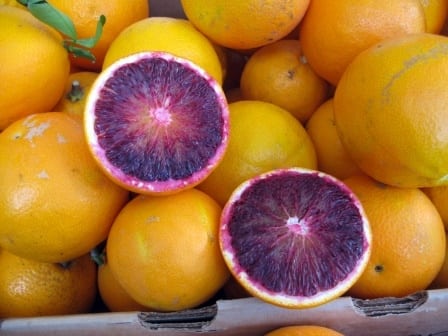
Blood oranges are common sweet oranges with red colour in the skin and/or flesh. The pigmentation develops best inland in dry climates with warm to hot days and cold nights.
Blood Orange –Arnold
This variety produces better colour in cooler climates.
The smallish, fruit ripens mid-winter and has a distinctive tang with the red pigmentation. The tree is also small and bushy, making it suitable for pots or a small garden.
Blood Orange – Cara Cara
Is a Navel orange, producing large, seedless fruit that are very sweet. Unlike other blood oranges, that produce the red pigmentation along the veins in the flesh of the fruit, the Cara flesh is all the same colour. Temperature can also affect the colouring.
Blood Orange – Maltese
An old variety of blood orange that lacks colour pigmentation, when grown in our southern climate.
Sour Oranges
Seville Orange (Citrus aurantium)
Seville sour orange trees are vigorous and hardy. Growing 4 to 6 metres in height, they are attractive garden and street trees and their fruit makes excellent marmalade.
Chinotto or Myrtle-leaf Orange (Citrus myrtifolia)
The chinotto is a natural dwarf tree, that grows slowly into a medium to large shrub. It makes an excellent potted specimen and is quite good for Marmalade.
Bergamot (Citrus aurantium)
The rind of this orange fruit is used in the fragrance industry. The juice can also be used as a substitute for lemon juice and in Earl Grey Tea. The fruit has a yellow colour similar to a lemon. The actual fruit of the bergamot orange itself, is not usually eaten. The tree is vigorous and strong growing.
Lemon (Citrus limon)
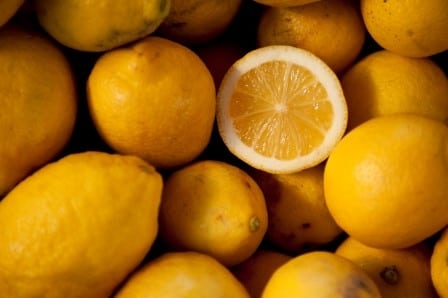
The lemon is more tolerant of heat than most citrus, and will ripen well in cooler areas. The tree can be frost sensitive. However we have three very vigorous and productive trees growing here in the cool-climate of Kyneton.
‘Lisbon’
Produces prolific crops of excellent quality fruit with thick skins. The heaviest crop matures in winter and spring, with a smaller summer crop ‘Lisbon’ is better adapted than ‘Eureka’ to colder conditions and produces much better quality fruit. The tree has thorns.
‘Eureka’
Somewhat rougher skinned fruit than ‘Lisbon’ but has excellent internal fruit quality. This tree has thorns and is best suited to milder climates. The thornless variety ‘Wiffen’ has no thorns and is similar to Eureka.
Meyer
The main crop matures in early winter. This fruit originated from China and is believed to be a natural hybrid between lemon and possibly orange. The fruit has smooth orange-yellow skin and is very juicy with a sweeter, less acid lemon flavour. Almost thornless and crops prolifically. Meyer lemon is more cold tolerant than the true lemons.
Lemonade
A low-acid lemon-like fruit, with a mild flavour, that can be eaten fresh. Moderately thorny, will produce fruit for most of the year.
Mandarin (Citrus reticulata)
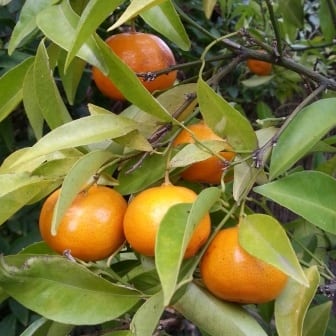
Easy to peel with soft flesh and an aromatic flavour, mandarins are one of the best citrus, for eating fresh from the tree.
Trees are highly adaptable, thriving in the tropics, but are one of the most cold-tolerant of the citrus. Fruit is of better quality, when allowed to mature under warmer conditions. The tree is quite frost hardy, however the fruit are prone to frost damage.
There are many varieties of mandarin available to the home grower.
‘Satsuma’ or ‘Japanese Seedless’
Medium sized fruit with a smooth, easy peeling skin. Seedless, with mild, sweet tender flesh. Fruit does not keep well on the tree, but stores well under refrigeration.
Early fruit maturity and cold tolerance make ‘Satsuma’ suitable for cooler climates.
Clementines
Are a group of mandarin cultivars, grown extensively in the Mediterranean region. Trees grown in isolation from other citrus, develop fewer seeds. Conversely, mixed planting of different cultivars, increases cross pollination and consequent increasing seediness.
Imperial
Medium to small fruit, with easily peeled, thin skin. Fruit can be picked over many weeks. It is medium in size, vigorous, upright and bears heavy crops. Cincturing at the bud-union is often a problem with Imperial mandarins on Trifoliata rootstock. This can be overcome by use of a sweet orange interstock.
‘Emperor’
Produces medium to large fruit with a loose skin and moderately few seeds. The fruit can become dry and puffy soon after maturity.
‘Dancy’
Some consider the flavour of ‘Dancy’ to be the best of all the mandarins. The tree is cold tolerant, but the fruit is not. It is sometimes called the 3 week tree. Week one the fruit is tart, week two it is perfect, in week three the fruit is puffy.
This fruit is sometimes called a tangerine. However, this is a marketing term, and it is actually a true mandarin.
‘Hickson’
Medium sized fruit with easy to peel skin and few seeds. Easy to grow in Melbourne.
Nobilis
Small to medium sized fruit. Heavily planted in the late 1940’s, because its fruit remained juicy, on the tree without drying out. The oily skin made peeling a messy process, and as a result has virtually disappeared, except as a collector’s tree.
‘Ellendale’
Believed to be a tangor (mandarin x orange). Medium to large fruit. This tree can be difficult to grow.
‘Murcott’
An American hybrid, which is possibly a tangor. Its fruit is large, bright and very sweet and juicy, with many seeds. It Keeps well, after picking at maturity. Fruit will remain firm on the tree after maturing, but will eventually dry out.
‘Kara’
Juicy flesh, rich flavour and few seeds. The fruit holds very well on the tree for a mandarin. This is a great early summer mandarin. It may prove difficult to locate Kara mandarin trees as they have fallen out of favour with gardeners in the last decade.
Silverhill
Suited to cold-climates. It is a seedless variety, producing fruit with smooth, thin skin, and sweet, juicy flesh.
‘Okitsu Wase’
It is suited to cold-climates. Slightly flat fruit, good flavour due to low acidity. Seedless and early maturing. Heavy cropping.
Tangelo (Citrus x tangelo)
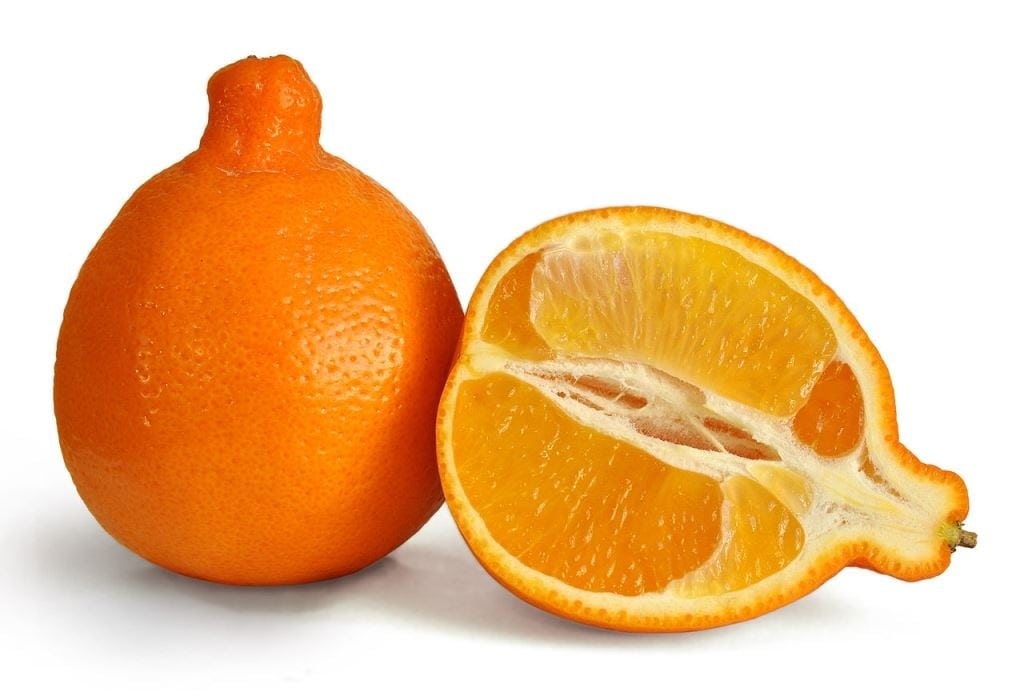
Tangelos are self-fertile hybrids, crosses between ‘Dancy’ mandarin and ‘Duncan’ Grapefruit. Noted for their soft melting flesh, abundant juice and mandarin flavour with a suggestion of grapefruit.
Varieties include ‘Orlando’, ‘Minneola’ and ‘Seminole’
Grapefruit (Citrus paradise)
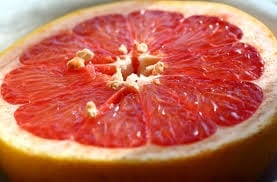
Grapefruit are attractive, large spreading trees with glossy deep green foliage. The fruit is eaten mainly fresh, but it is also used to make juice and marmalade.
Grapefruit trees need a warm to hot climate, to develop the best fruit size, quality and flavour. In cooler southern climates the fruit tends to be smaller, thicker skinned, later-maturing and not as sweet or juicy.
The main varieties of true grapefruit to consider growing are ‘Marsh Seedless’ or ‘Thompsons Pink’. The pigmented varieties such as ‘star Ruby’, ‘Red-Blush’, ‘Rio-Red’ and ‘flame’ are only suited to warmer microclimates, and will probably not develop their characteristic pink pigmentation.
There are several “Grapefruit-like Fruits” that can be grown in cooler climates, these are probably better choices:
Wheeny
A large greenish-yellow, very seedy fruit and a tart flavour. Not grown commercially because of the seediness of the fruit. Wheeny is one of the quickest and strongest growing citrus varieties and produces a large tree. Wheeny fruits heavily and reliably.
Poorman, Poorman Orange
Medium to large pale orange-yellow fruit with some seeds. Very juicy, pleasant flavour with a grapefruit after-taste. Fruit holds very well on the tree. A good shade tree for the garden.
Chironja
Pronounced ‘cheer own aa’. It is a medium to large fruit, butter-yellow in colour and easy to peel. It has lots of sweet juice, with a light grapefruit after-taste and no bitterness. A much better alternative for cooler climate gardens than ‘Marsh Seedless’ and its cultivars.
Limes
Tahiti, Tahitian, Bearss or Persian Lime (Citrus x latifolia)
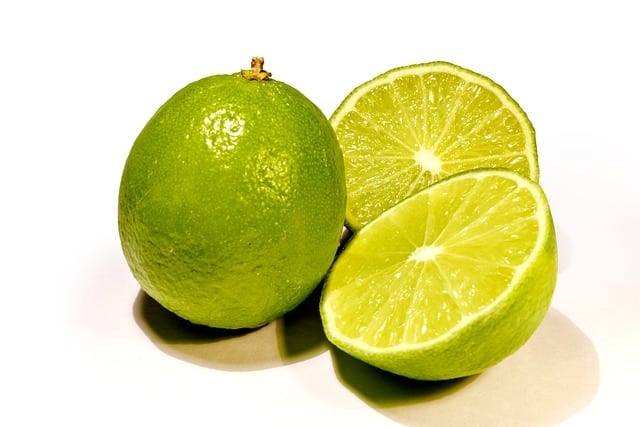
More or less “ever bearing” all year round in a tropical environment. However, it produces only one main crop, in winter in temperate climates.
Cool growing temperatures and its sensitivity to frost, can slow the growth of this tropical variety. Under these conditions, the tree is only moderately vigorous, medium in size, nearly thornless and spreading.
The best way to grow a Tahiti lime, in a cool climate, is in a large pot or tub. It needs a warm, sunny, wind protected spot, such as on a patio or veranda and preferably facing to the north. We have a very productive tree in our protected citrus grove in Kyneton.
West Indian, Key or Mexican Lime (Citrus aurantifolia)
It’s the best lime to season fish. Fruit is quite small, moderately seedy and juicy. Has dense foliage and thorny branches.
West Indian lime is very cold sensitive, even more so than Tahitian lime. It must have a very warm, protected site, to succeed outdoors. Will grow well in a pot or tub in a greenhouse.
Rangpur lime (Citrus x limonata)
Rangpur lime, is a cold tolerant, natural mandarin x lemon hybrid. Acidic, slightly seedy fruit that can range from pale to dark green, and to reddish-orange at maturity. Fruit will hang on the tree all year round.
Kusaie lime
Yellow, smaller form of Rangpur, but with a distinctly different flavour. In all other respects is identical.
‘Sublime’
Developed in Australia and has leaves that are a lot smaller than the traditional lime, producing full size juicy fruit. This improved variety is compact and virtually thornless. It is great for growing in pots, and is a good fruiting variety, with plenty of juice. ‘Sublime’ is perfect for patios, only growing to 1.5m tall.
Makrut lime (Citrus hystrix)
Previously known as Kaffir lime, but now re-named. A very thorny bush with aromatic leaves used widely in South-East Asian cooking. In cooking, use only young, fully matured leaves.
Fruit is rough, bumpy and inedible, although the oil from the skins is used in hair shampoo and is believed to have insecticidal properties.
Makrut lime can be propagated by cuttings.
See also ‘Limequat’ under Cumquat and Hybrids.
Cumquat and Hybrids
Cumquat (Fortunella spp.)
Cumquats are attractive, small leafed and slow growing, cold tolerant trees. They are often grown as an ornamental and well suited to tubs. They have prolific crops and early maturing fruit. Cumquats flower in early summer unlike other citrus which flower in spring.
‘Nagami’ (Fortunella margarita)
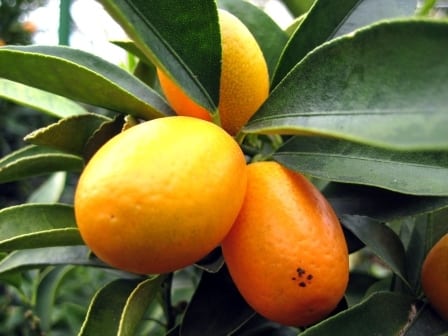
Small oval or egg-shaped fruit, with deep orange coloured, aromatic skin. Fruit can be eaten whole, or its sweet skin and tart pulp, combined to make marmalade, glace or liquors.
Slow growing tree with long, pointed glossy leaves and a more robust grower than ‘Marumi’
‘Marumi’ (Fortunella japonica)
Round and juicy fruit, with thin, non-oily skin.
Limequats
Attractive ornamentals, that are more cold tolerant than true limes. It has small, light orange fruit with sharply acid flavoured juice.
Calamondin, Calamansi or Calamandarin (Citrus madurensis)
Often incorrectly called a cumquat. Small and juicy fruit with loose, bright orange skin and an acid flavour.
Calamondin will grow into a large tree if planted in a favourable garden situation. Root restriction controls its size, but not its prolific, year round fruiting habit.
Citron (Citrus medica)
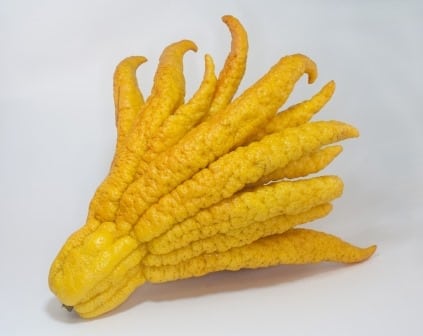
These fruits have religious significance in Asia and the Middle East. Citron trees produce only moderate growth and have a limited life span in cool climates. They are a challenge for Melbourne gardeners to grow, and require a warm, frost free, subtropical climate to survive.
Some of the varieties are: ‘Corsican’, ‘Etrog’, ‘Bengal’, ‘Palestine’ and Buddha’s Hand or fingered citron.
Pummelo, Pomelo or Shaddock (Citrus maxima)
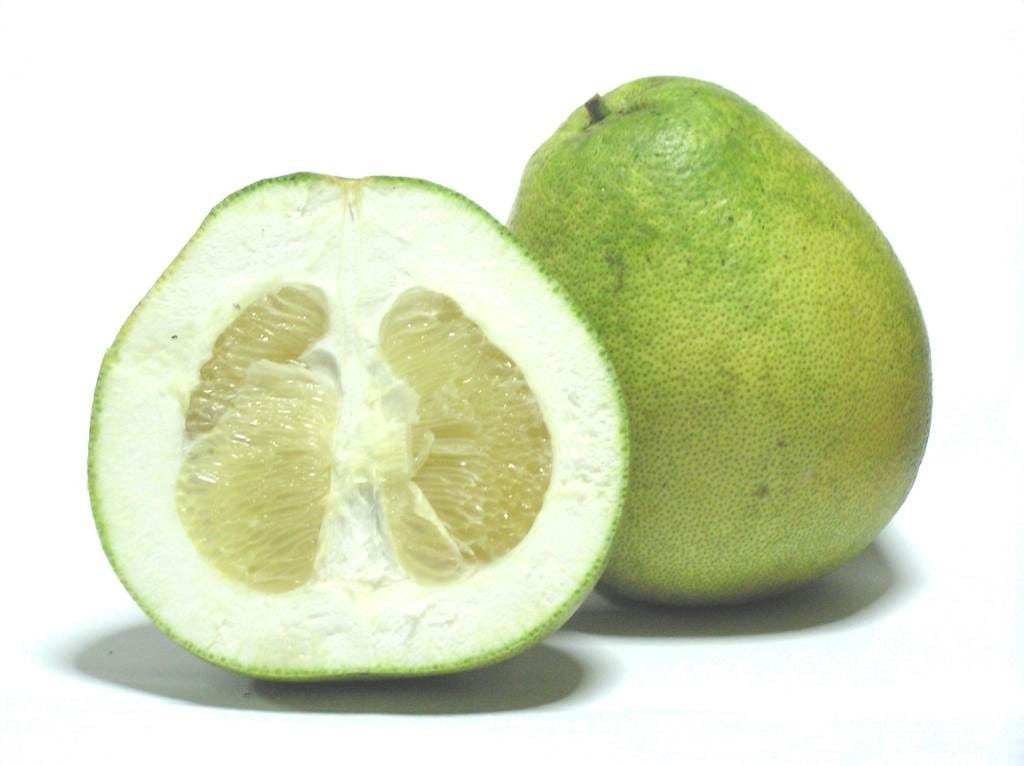
Pummelo fruit varies in size from 10 to 25cm in diameter, and weighs from half to two kilos. The rind is normally 10 to 30 mm thick, and the fruit can be round or pear shaped.
Pummelo trees generally have an untidy habit and vary in size. Although they will grow and fruit, in frost free southern climates, fruit quality and productivity is far superior in the tropics.
Australian Native Citrus Varieties
Finger Lime (Citrus australasica)
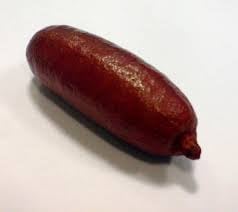
From rainforest regions of northern New South Wales and Southern Queensland with elongated yellow-green to purple fruits. Finger limes can be grown in temperate areas with deep loamy soils. Soil should be nutrient rich, with high levels of organic matter with slightly acidic soil. It is able to withstand light frost levels. In cooler climates, a semi shaded area in a north facing site is preferred. Mulch during spring and have a good water regime to keep soil moist during summer and lightly prune annually after fruiting in autumn. No fertiliser is required for maintenance.
Round Lime or Dooja (Citrus australis)
From south-eastern Australia with round, green fruits
Desert Lime (Citrus glauca)
From the arid inland areas of Australia. Small round fruits are produced in summer.
Mount White lime (Citrus garrawayae)
Rare and endemic, to the Cook District of Cape York Peninsula.
Kakadu Lime or Humpty Doo (Citrus gracilis)
Grows in eucalypt woodland in the Northern Territory and was first described in the scientific literature in 1998.
Russell River Lime or Large-leaf Australian wild lime (Citrus inodora)
Rare, and endemic to northern Queensland.
Maiden’s Australian Wild Lime Citrus maideniana
This may be a subspecies of C. indora.
A number of cultivars have been developed in recent years. These can be grafted on to standard citrus rootstocks such as Trifoliata. They may be grown as ornamental trees, in the garden or in containers. Grafted standards are available for some varieties. The commercially available cultivars including:
- ‘Australian Outback’ (or ‘Australian Desert’), developed from several Desert Lime varieties
- ‘Australian Red Centre’ (or ‘Australian Blood’ or Blood Lime), a hybrid cross of Finger Lime and mandarin
- ‘Australian Sunrise’, a hybrid cross of Finger Lime and a calomondin which is pear shaped and orange inside
- ‘Rainforest Pearl’, a pink-fruited form of Finger Lime
- ‘Pink Ice’, purplish to brown skin on the outside with clear to pink vesicles on the inside. Fruits well with a great flavour. Produces an unusual finger shaped fruit, that has individual vesicles inside that pop out when squeezed. Looks very similar to caviar. Has a strong limey taste. Great for drinks, used as a garnish or mixed through salads.
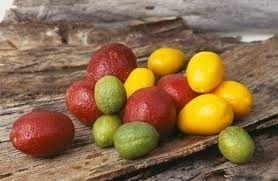
Maturity periods for harvesting common citrus varieties in Melbourne.
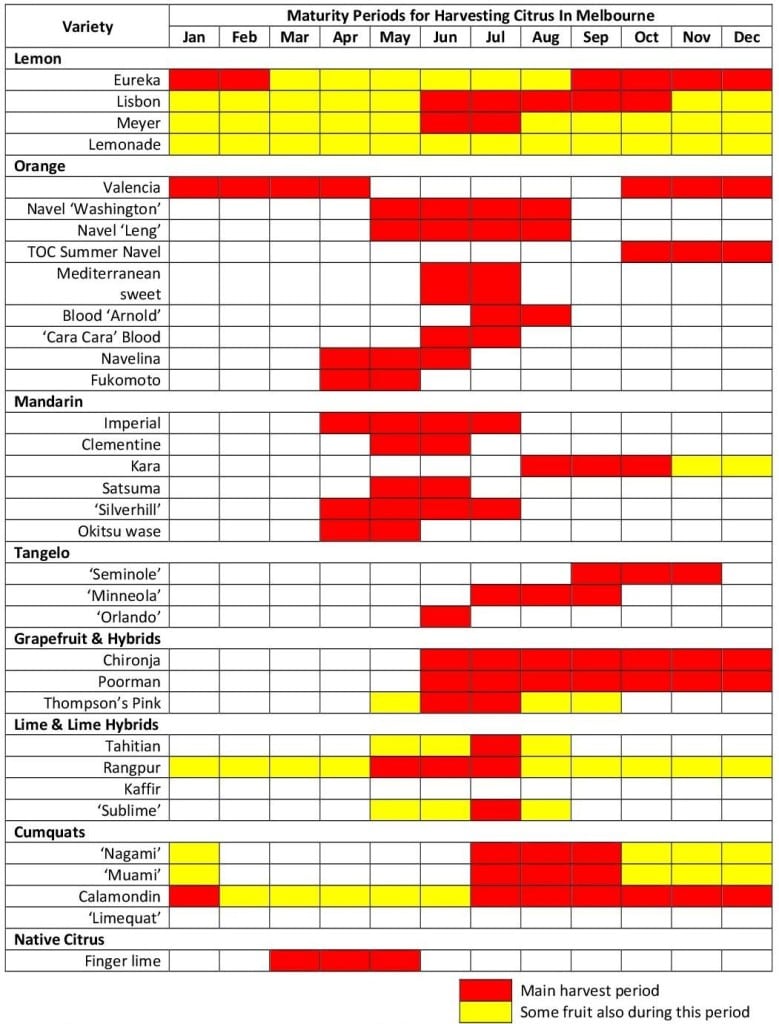
Note: these fruiting times are general guides for greater Melbourne. They may vary by up to 6 weeks in different microclimates.
Check out my ripening chart for other fruit tree varieties such as stone fruit, apples and pears.
Recommended Varieties for a Citrus Grove in Melbourne
The planting options for growing citrus in Melbourne are numerous. Based on having room for 10 to 12 trees in Melbourne, the following selection would be recommended to provide almost year round supply of citrus.
- Lemon x 3: ‘Lisbon’, ‘Eureka’ (or ‘Wiffen’) & ‘Lemonade’
- Orange x 2:
- Hot microclimates: ‘Valencia’ and Navel ‘Washington’
- Warm microclimate (most of suburban Melbourne): Navel ‘Toc Summer’ and Navel ‘Washington’
- Colder areas (such as the hills) ‘Navelina’ or ‘Fukomoto’
- Mandarin x 2:
- Milder areas ‘Imperial’ and ‘Kara’
- Colder areas (such as the hills): ‘Silverhill’ and ‘Okitsu wase’
- Tangelo x1: ‘Seminole’
- Grapefruit x 1: Chironja (or Poorman, Wheeny or Thompson’s Pink)
- Tahitian Lime x 1 (or ‘Limequat’)
- Cumquat (any) x 1
- Native Finger lime x1
Note: As Makrut (Kaffir) lime is generally only used for its leaves, it is quite common to graft a branch of this on the lower part of another citrus tree to save space.
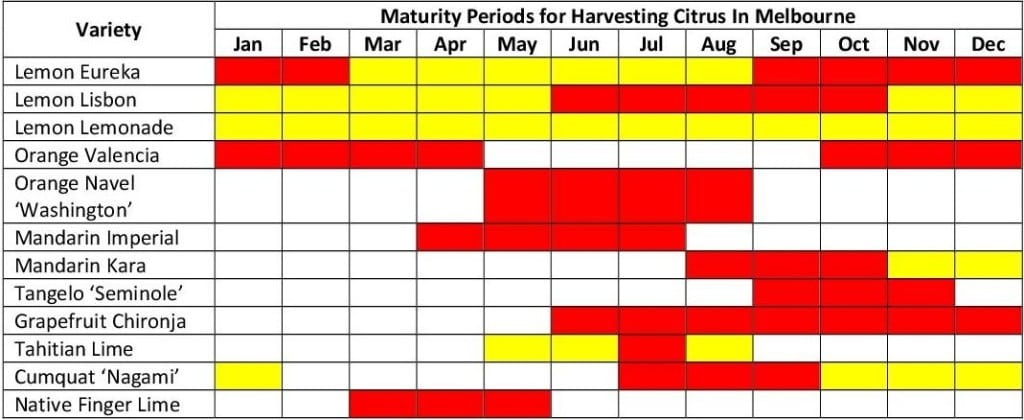
Best Citrus Rootstocks for Melbourne
There are many rootstocks suitable to Melbourne’s soil and climate available for apples pears, stone fruit, and other fruit trees. However, the only rootstock that should be used for growing citrus in Melbourne (and all of Victoria) is “Trifoliata”. Any other citrus rootstocks will perform poorly.
There is a dwarf trifoliata variety called “Flying Dragon” which restricts most citrus to only 1.5 metres tall and is ideal for growing citrus in pots. I find that trees grafted onto Flying Dragon rootsotck are quite insipid and not overly productive. I prefer Trifoliata in most situations.
Don’t underestimate the importance of choosing the right rootstock for your fruit trees. It can make such a difference to the growth habit, and also the survival of your plants in the long term.
Characteristics of Trifoliata and ‘Flying Dragon’ rootstocks
- Very resistant to Phytophthora
- Susceptible to Psorosis
- Very susceptible to Exocortis
- Tolerant of Tristeza
- Resistant to citrus nematodes
- Good fruit production
- Excellent fruit quality
- Average fruit size
- Mid-season fruit maturity
- Excellent cold tolerance
- Low salt tolerance
- Low lime tolerance
- Very tolerant of poor soil drainage (relative to other citrus rootstocks)
- Good replant growth
- Average longevity
- Will support most citrus scion except ‘Imperial’ Mandarin.
Want to know more about Growing Citrus in Melbourne?
This is Part 1 of a 5 part guide to growing citrus in Melbourne. The links below will take you to the other four parts of my Melbourne citrus growing guide.
Citrus Growing Guide Part 2: Where and How to Plant Your Citrus Tree
Citrus Growing Guide Part 3: Ongoing Care and Management of Citrus Trees
Citrus Growing Guide Part 4: Pruning and Shaping of Citrus Trees
Citrus Growing Guide Part 5: Citrus Pests, Diseases and Problems in Melbourne
My citrus growing guides are based on my own experience, as well as the following books. They are all invaluable resources for the home gardener based in Melbourne. I strongly recommend you have a read of them, if you want to know more about growing citrus in Melbourne:
Ian Tolley: Commonsense Citrus, 2017
Bruce Mophett & Ian Tolley: Citrus, A Gardener’s Guide, 2009.
Louis Glowinski: The Complete Book of Fruit Growing in Australia, 1997.
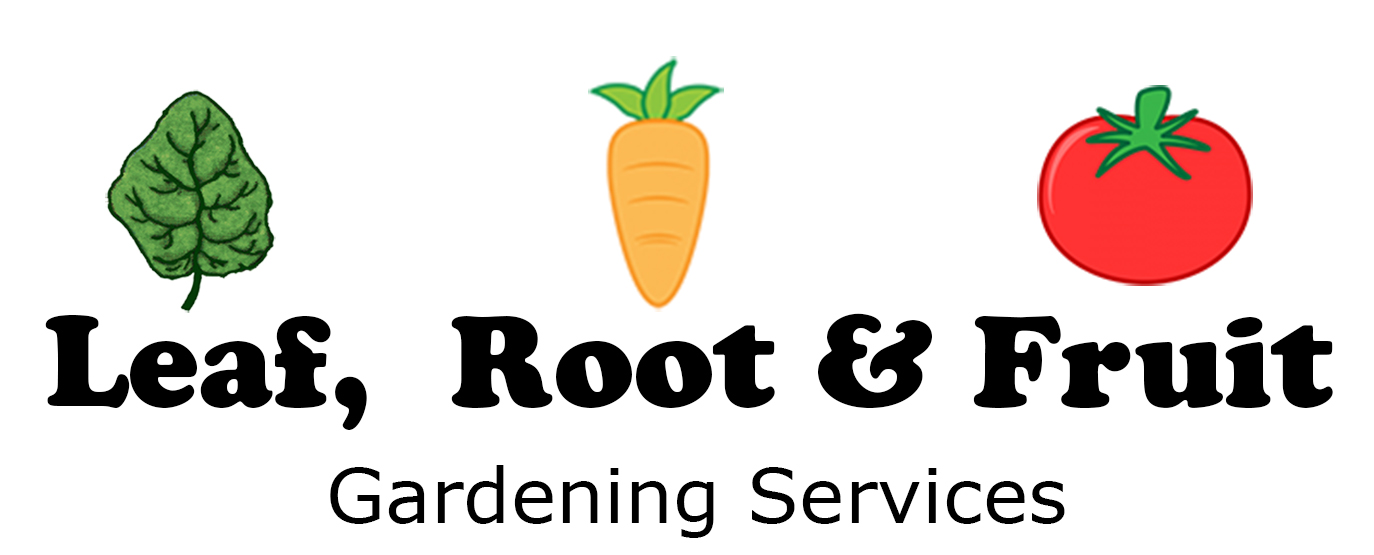
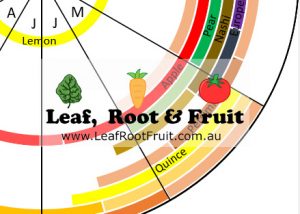

Hi Duncan,
I’ve just come across your site after looking at many others and it’s wonderful. Well done.
My question is I’m in Melbourne and i’ve got a 4 yo dwarf valencia in the ground which has got about 10 6cm fruit. They have been this size for the last 3-4 months. Last year was a similar story with half a dozen fruit remaining a similar size for about 8 months. Is there anything i should be doing re watering, fertilising etc?
Feedback appreciated.
John
Hi John,
Thanks for your query. It’s normal for the fruit to grow slowly. It can take up to 14 months for some varieties of citrus fruit to develop and ripen from flowering. Citrus require a lot of water, and nitrogen. For more information on the feed and water requirements of citrus- check out Part 3 of our citrus guide.
Thanks
Duncan
Very good information. Really appreciated.
Thanks for the great feedback Moti.
Good Luck & Happy Gardening
Excellent resource. Look forward to next instalment.
Need more info on making navels sweeter and more juicy in cool environment.
Hi Geraldine,
Citrus are not that suited to Melbourne’s climate. They evolved in a sub-tropical environment. So there’s not much more you can do, other than influence the microclimate, by eg, growing in a greenhouse or planting the tree against a north facing brick wall.
hope that gives you some ideas to work with.
Stay Safe & Happy Gardening!
Duncan
hi Duncan, Help! I have been given a reasonable sized orange tree as a Christmas gift by my nephew and the only space I have available is in a gap between two camellias in a camellia hedge. Will the camellias kill the orange, apart from that the site seems compatible for both. I would end up blending the plants as a hedge, I am not expecting fruit but would like the gift to be visible.
I think this is an unusual problem, can you help? with thanks
Elise
Hi Elise,
We’ve successfully grown citrus and camelias together as an informal hedge. Provided you have good drainage and look after the tree as per usual it should be fine.
Good Luck & Happy Gardening!
Duncan
Excellent resource thanks.
Glad you enjoyed it!
My Washington Orange tree was supposed to be a miniture but is now 12ft hight. All I want to know is when I can prune it.
Hi Judy,
assuming you are in Melbourne, then you would prune it as soon as you have picked all the fruit, likely to be in June/July, possibly a bit later.
That timing may have to change if you are in another part of the world to Melbourne.
Good Luck & Happy Gardening!
Duncan
Hi thanks for posting this – it’s very helpful. This is one of very few places in Australia where I can find a reference to the Chironja. Do you know of anywhere that sells them here?
Many thanks, Angus
Hi Angus,
I occasionally see them for sale, but not often. Try somewhere like Bulleen Art and Garden, who tend to stock a wide range of citrus. They may be able to get one in for you.
Good Luck & Happy Gardening!
Duncan
Wow so comprehensive. Thank you so much. I wish I had read this before buying some of my citrus plants but at least I know what to do next time.
Glad you’ve found it useful Sajaad. We’re always learning in a garden!
Thank you for the excellent site and tips.
I see that you have noted that Trifoliata is not very salt tolerant, do you have a recommendation for a commercially available root stock that is more suitable for a coastal (but still southerly) environment?
Thank you
Hi Reins,
If you’re in Victoria then I’d still be inclined to give Trifoliata a go.
Happy gardening!
Thank you
Hi. Thank you for your article. Very informative. I’m interested in grafting a Yuzu seedling to a Trifoliata or ‘Flying Dragon’, but I can not find a nursery/shop in Melbourne. Where can I purchase?
It can be difficult to source citrus rootstocks. you might need to order online. I think Google will be your best bet in this instance.
Good luck with the search.
Duncan